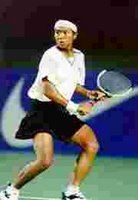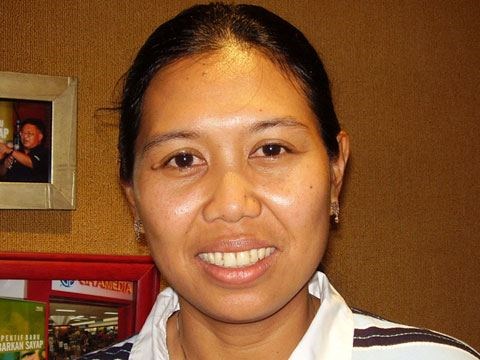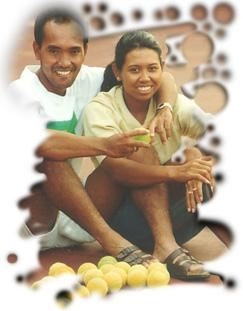 |
HERO??? SUPERMAN or BATMAN??? In my opinion, a hero is neither a Superman nor a Batman. A hero is someone who always struggles and tries to do the best to reach what he/she’s dreaming of and brings the name of their country to international events. I adore Yayuk Basuki as my hero.
From the tennis court, she changed her profession into a businesswoman although her international tennis career still has a chance to develop. She is Nani Rahayu, who is famous with the name Yayuk Basuki.
 |
Mass media and most people in the world called her “The Jaguar of Asia”. This name was gotten when she won the tennis championship in Pattaya, Thailand, 1991. her career is indeed bright. She was ‘The Queen of Tennis’ from Indonesia before Wyne Prakusya and Angelique Widjaya. Her aspiration to be an international tennis player had been on her mind since she was 5 years old. Her father, Budi Basuki—who is a police officer in Purwokerto, Central Java—and her mother, Sutini, introduced her to tennis and trained her.
When she was 13 years old, Yayuk, who is the fifth child in the family, joined a tennis club in Ragunan, Jakarta, until 1989. Yayuk was then trained by some coaches. But the one who had the biggest influence on her career is Mien Gondowidjojo—whom she considered as own mother. In the next year, she joined Pelita’s Club.
 |
She began concentrating on professional tennis since her coming from Beijing in October 1990 and she was trained by George Jiri Waters. At the Challenge II tournament in Jakarta, Yayuk got the 259th position of WTA in February 1991—in early April 1991, at Pattaya tournament, her position went up into 86th position of WTA.
At the club owned by Aburizal Bakrie, people saw Yayuk, a girl coming from Yogyakarta and born on November 30th, 1970, reach success. She started going abroad. Nevertheless, her path to success was not easy. She often got in trouble with Pelti (The national tennis association) for not representing Indonesia in international tournaments. Many people accused her of being selfish.
Many obstacles came to her career. She was ever eliminated from Indonesian Fed Cup team. It was because she and Suharyadi (her husband as well as her coach) were considered to be impolite when they wrote a letter to the world women tennis board for choosing the court where the Indonesian team played. Yayuk and Suharyadi finally walked out from Indonesian team after the chairman of National Tennis Board, Wimar Witoelar, resigned—he was very closed to Yayuk and Suharyadi.
After that, she made a decision: to go international to pursue a target of being the 20th position. The schedule of international tournaments were at the same time with the SEA Games and PON. She had to leave these two tournaments. She hoped the government paid more attention to young athletes, so that the Indonesian team would not focus on one athlete only.
She esthablished YBM (Yayuk Basuki Management), an organization which managed all of her tournaments. She managed this organization together with Wimar Witoelar. Then, YBM was managed by Robert Manurung, who dealt with promotions, finances, and training programs of Yayuk. She hoped this system could be an example for other Indonesian atheletes if they wanted to get involved in professional tennis.
When Yayuk entered the big eight of Wimbledon, she had been noted to be the first Indonesian women who got into ‘Eight Club’, an association which gathers alumni of all big eight players of the tournaments. Being a member of Eight Club, Yayuk could enjoy all VIP facilities including the first class hotels everywhere in the world—just like Martina Hingis, Steffi Graff, Monica Seles, or Gabriela Sabatini. In Asia, besides Yayuk, the one entered Eight Club was only Kimiko Date from Japan.
All of these, Yayuk said, were because of her husband, Suharyadi. Her husband sacrificed many things to train Yayuk for her advance. However, Suharyadi still played well.
The issues of Yayuk’s retirement had been heard when she won the Asian Games in Bangkok, 1998. In 1999, she was pregnant, she didn’t “touch” her racket. Nonetheless, Pelti association hoped Yayuk would play again. At that time, Angelique Widjaja, Wyne Prakusya, and Romana hadn’t existed.
She was indeed in a tennis-loving family. Her father, Budi Basuki, was a table-tennis player on PON 1954. He mastered not only table-tennis, but also outdoor tennis, badminton, and soccer. In addition, her elder sister, Nani Sudarmi was a national tennis player in the 1980s. Her mother, Sutini, also liked tennis and badminton. Loving sports, Sutini even was not aware that she was pregnant.
The story of her birthday is unique. When her mother was busy cooking in the kitchen, the small chair she used to sit on was moved by Yayuk’s elder sister so that when Sutini wanted to sit, she fell down. Suddenly, Sutini felt that it was nearly the time for her to give birth. The way to the AURI Hospital in Pakualaman was 5 km away from her house, the head of her baby was going out a little, but she could still handle it. Her baby, Yayuk Basuki, was born safely on Ied Fitr, November 30th, 1970.
The most interesting experienced for Yayuk was when she became a team member of PON from Yogyakarta, she was in the fifth grade of elementary school. She could even defeat her elder sister, Mamiek in Pakualam VIII tournament. This loss made Mamiek cry.
The most amazing experience and memory for her was when she could meet a challenge from Aburizal Bakrie who targeted her to enter the international big 50th position. Her success made her win a green Nissan sport car from abroad. This achievement was indeed tiring. Although defeated by Martina Navratilova, she could reach the 42th position.
Along her career, she had met great tennis players like Steffi Graff, Monica Sales and Arantxa Sanchez even though she couldn’t defeat any of them until the end of her career. She was surprising many people in the world by defeating some other tennis players like Anke Huber (Germany), Mary Joe Fernandez (USA), Nathalie Tauziat (France), Lindsay Davenport (USA), Gabriela Sabatini (Argentina) on the Federation Cup, April 1994, and also Martina Hingis (Swiss) on Federation Cup 1996.
The last moment for Yayuk to reach the highest position was when she played in the Birmingham Tournament, June 1997. In this tournament, Yayuk successfully entered the final, though she failed to be the winner, defeated by Nathalie Tauziat. Besides that, Yayuk had never entered the quarterfinal in the Wimbledon Tournament in which she got the 19th position.
Since she was a child, she had practiced a lot. She started from 5.30 A.M. until 6.30 A.M. playing tennis under her father's guidance. Her father trained her on the soccer field, not the tennis court. Her father trained her by giving balls to many sides and she had to catch the balls. After lunch, she practiced in front of wall as her opponent—by striking the balls which bounced back into her. After her father came back from working, she practiced until 6.00 P.M.
Yayuk married to Suharyadi when she was 24 years old. Suharyadi had known Yayuk since the age of 17. Suharyadi was a number one tennis player, who previously worked at PT Yarynara as a director. His company dealt with advertising, event organizing and garments. In 1992, their love was growing. His mother, who was in bad condition, made them decide to get married soon. They got married on January 31th, 1994 in Yogyakarta. They worked professionally although they were husband and wife.
Her mental toughness and enthusiasm can be a good model. She only had two choices: win or lose until the end of the game. She always tried to play her best in every game. She never wasted any opportunity and she was very disciplined and punctual. Time is gold for Yayuk. She wanted to have only one child. And she will never force her child to be a tennis player. The name of her child is Yarynara Sebrio Suharyadi.
Page created on 2/10/2008 12:00:00 AM
Last edited 2/10/2008 12:00:00 AM
